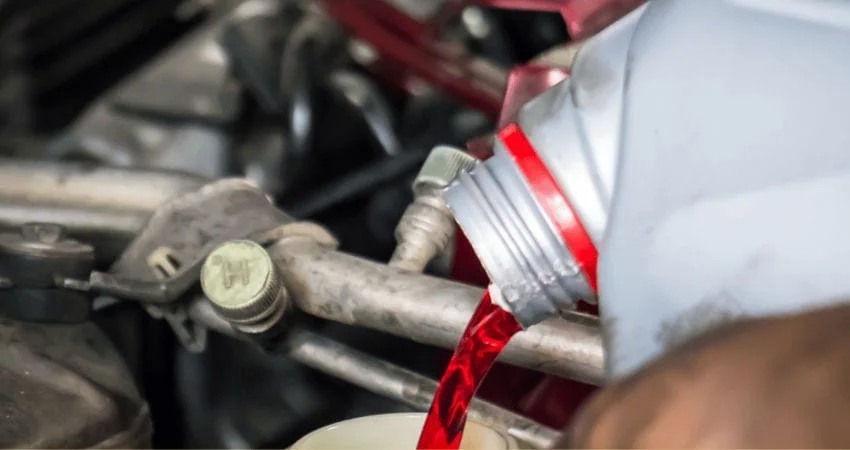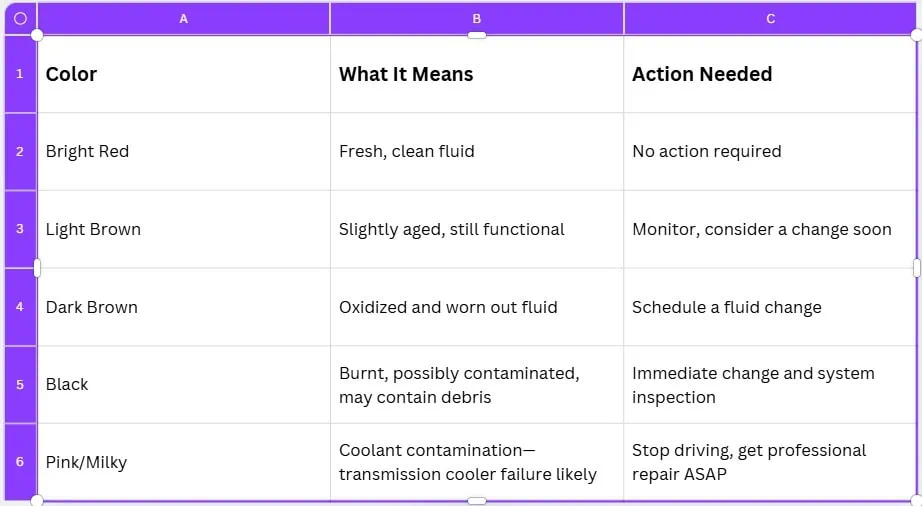What color is transmission fluid? Knowing what color your transmission fluid should be can help you avoid costly repairs. A quick check of the dipstick or spotting a stain in your driveway can give you real insight into your vehicle’s condition.
Let’s look at what each transmission fluid color means, what causes it to change, and what actions you should take based on what you see.
Transmission fluid is usually bright red when it’s in good condition. It may also appear light pink if it’s very new. This color helps you easily spot leaks and also gives you a quick visual clue about the fluid’s condition.
Fresh, high-quality automatic transmission fluid (ATF) should be:
- Bright red or light pink
- Clear, not cloudy
- Slightly sweet or tart in smell
The red dye is added to help drivers and technicians identify leaks and to notice any deterioration quickly. As fluid ages or becomes contaminated, it changes color—each stage indicating something different about your transmission’s health.
The correct color of ATF depends on its age, the type used, and whether there’s been damage or contamination. A premium fluid like Amsoil Synthetic Multi-Vehicle ATF holds its color longer and provides consistent protection, even under extreme driving conditions.
In short:
- Bright red = healthy
- Light brown = aged
- Dark brown or black = burnt or degraded
- Pink or milky = coolant contamination (urgent issue)
What Causes Transmission Fluid to Change Color?
Several factors lead to color changes in your ATF:
- Heat: Excessive heat causes fluid breakdown and oxidation, which darkens the fluid.
- Friction debris: Worn clutch materials and metal particles discolor the fluid.
- Contamination: Water or coolant infiltration causes a milky or foamy appearance.
- Additive wear: Over time, additives in the fluid wear out, reducing its performance and clarity.
Why Fluid Color Matters
Your transmission relies on clean fluid for proper operation.
Dark, burnt, or milky fluid can lead to:
- Slipping gears
- Delayed or rough shifting
- Transmission overheating
- Premature internal wear
- Complete transmission failure
If you ignore these signs, you may end up needing a full rebuild or replacement—easily costing $2,000–$4,000 or more.
Most vehicles with automatic transmissions have a dipstick under the hood.
Here’s how to check:
- Warm up the engine and park on level ground.
- Leave the engine running.
- Pull the transmission dipstick, wipe it clean, reinsert it fully, then pull it out again.
- Look at the color, consistency, and smell of the fluid.
Tip: If your car doesn’t have a dipstick, check during regular service appointments or ask a mechanic.
What to Do Based on Fluid Color
- Red and clear: Everything’s good.
- Light brown: Safe to drive, but plan for a change soon.
- Dark brown or black: Schedule a fluid change. You may also need a filter replacement.
- Pink or milky: Stop driving. This is often a sign of coolant contamination. If not fixed quickly, it can destroy your transmission.
Choosing the Right Transmission Fluid
Not all ATF is the same. Using the wrong fluid can cause poor shifting, overheating, or even failure.
That’s why I recommend Amsoil Synthetic Multi-Vehicle ATF. I’ve used it in vehicles that experience both extreme cold and high-traffic heat. It stays clean longer, resists breakdown, and delivers smoother performance over time.
Whether you drive a family SUV in Canadian snow or a pickup truck through hot southern states, this fluid performs reliably. It meets or exceeds most OEM specs and gives peace of mind.

